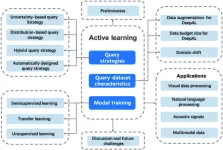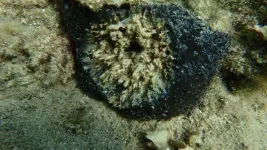(Press-News.org)
A Chinese research team wrote a review article on deep active learning, an increasingly popular method of combining active learning with deep learning for sample selection in the training of neural networks for artificial intelligence tasks. It was published Nov. 30 in Intelligent Computing, a Science Partner Journal.
Given that research on deep active learning techniques in the context of foundation models is limited, this review offers some insights into this topic. It surveys existing deep active learning approaches, applications and especially challenges "in the era of foundation models," concluding that it is necessary to develop customized deep active learning techniques for foundation models.
Recently, the success of foundation models has called attention to the data-intensive nature of artificial intelligence. Foundation models are generally built with deep learning technologies and trained on massive labeled datasets. Only with accurate data labeling or annotation can models make accurate predictions and adapt to various downstream tasks. However, producing such data is laborious, difficult and expensive.
This is where deep active learning comes in. Using active learning to train deep learning models can effectively reduce the heavy labeling work because active learning only selects and labels the most valuable samples. As a result, deep active learning can smooth out the learning process and bring down the cost, contributing to "resource-efficient data that are robustly labeled."
In line with the structure of a typical active learning framework, which includes query data, query strategy, human annotation and model training in a cycle, deep active learning approaches relate to query strategies, query dataset characteristics and model training.
Effective query strategies are the key to selecting the most valuable samples for data annotation. Active learning query strategies generally come in three categories, membership query synthesis, stream-based sampling and pool-based sampling; this categorization is based on the flow of unlabeled samples to the data annotator.
For deep active learning algorithms, on the other hand, there are four kinds of strategies: uncertainty-based, distribution-based, hybrid and automatically designed.
Uncertainty-based strategies identify the samples with the highest uncertainty, distribution-based strategies focus on the underlying structure of the data to identify representative samples and hybrid strategies use a combination of uncertainty-based and distribution-based selection metrics; all three types are designed manually, thus are not easily adapted for deep learning models and are over-dependent on human expertise. These problems can be addressed by automatically designed strategies, which use meta-learning or reinforcement learning.
Query strategies must be tailored to various dataset characteristics, such as the size, budget and distribution of the query dataset, which is a subset carefully selected from a larger dataset to be labeled. Specifically, data augmentation is often used to improve the diversity and quantity of labeled training data; different strategies should be adopted to suit different budget sizes and to cope with the mismatch between the distributions of labeled and unlabeled data — that is, the so-called domain shift problem.
For model training, the authors discussed how to combine deep active learning with current data-heavy mainstream methods, including supervised training, semi-supervised learning, transfer learning and unsupervised learning, to achieve optimal model performance.
The applications of deep active learning across various scenarios were then introduced, especially those involving costly, time-consuming data collection and annotation. As the authors observed, deep active learning has been used to process not only single-modal data such as visual data, natural language and acoustic signals, but also abundant multi-modal data.
However, the authors also pointed out that the majority of current deep active learning methods concentrate on task-specific models instead of comprehensive, data-intensive foundation models. To better integrate deep active learning into foundation models and maximize joint performance, several key challenges in training and refining foundation models need to be addressed, including data quality evaluation, active finetuning, efficient interaction between data selection and annotation, and the development of an efficient machine learning operations system.
END
Tsukuba, Japan—Forests, known as nature's "green dams," play a crucial role in replenishing Earth's groundwater reserves. However, overcrowding in planted forests due to lack of maintenance activities, such as thinning practices, is a pressing concern in Japan. This overcrowding causes substantial water loss from these forests into the atmosphere through a combination of soil evaporation and tree transpiration (Et) known as evapotranspiration. In the rich forests of Japan, Et is a major factor in the depletion of water resources. Therefore, accurately measuring Et across wide areas is currently a critical task because ...
About The Study: Among 170 patients primarily with COVID-19–related severe acute respiratory distress syndrome (ARDS) supported by venovenous extracorporeal membrane oxygenation (VV-ECMO), prone positioning compared with supine positioning did not significantly reduce time to successful weaning of ECMO.
Authors: Matthieu Schmidt, M.D., of the Sorbonne Université in Paris, is the corresponding author.
To access the embargoed study: Visit our For The Media website at ...
As the use of wearable technology grows, smart watches are marketed across the globe to consumers as a way to monitor health.
For some, they’re told by these devices that they have atrial fibrillation, an irregular heartbeat, which is known to increase the risk of heart attack and stroke.
“Unfortunately, this has led to a tsunami of healthy patients coming to clinics complaining about having atrial fibrillation, and we see many false positives without really having a way to use these devices clinically,” said Hamid ...
PRESS RELEASE FROM THE UNIVERSITY OF CAMBRIDGE
EMBARGOED UNTIL 10 AM LONDON TIME (GMT) ON FRIDAY 1 DECEMBER 2023
Images and paper available at: https://drive.google.com/drive/folders/1JRhAD1ESL6NZN7acEoZQcXCA9w50Gczr?usp=drive_link
Phonetic information – the smallest sound elements of speech – may not be the basis of language learning in babies as previously thought
Babies don’t begin to process phonetic information reliably until seven months old – which researchers say is too late to form the foundation of language
Instead, babies learn from rhythmic information – the changing emphasis of syllables in speech – which unlike phonetic ...
The scorching heatwaves of 2023's summer and autumn shook the world, raising a pertinent question: Will this lead into the warmest winter the globe has ever witnessed?
After a summer and autumn marked by extreme temperatures and a consistent global warming trend across oceans and landmasses, concerns mounted about what might follow. The global average temperature during June to October 2023 surpassed the 1991-2020 average by 0.57℃. August and September soared even higher, surpassing historical averages by 0.62℃ and 0.69℃, respectively, eclipsing the records set in 2016.
From hottest ...
Vibrio bacteria, named for their vibrating swimming motion, span approximately 150 known species. Most Vibrio live in brackish or salt water, either swimming free or living as pathogens or symbionts in fish, crustaceans, molluscs, and corals. Because Vibrio thrive at relatively high temperatures, outbreaks in marine animals are expected to become ever more frequent under global warming. For example, over the past few decades, Vibrio have been implicated in the ‘bleaching’ of subtropical and tropical corals around the world.
Now, researchers from Spain and Turkey have shown that Vibrio bacteria also play a role in outbreaks of mortality of an unrelated ...
BOSTON – Individuals can improve their brain care and reduce their risk of developing brain diseases such as dementia and stroke by focusing on a list of 12 steps covering modifiable physical, lifestyle, and social-emotional components of health.
The list was developed and validated in research published in Frontiers in Neurology by investigators from the McCance Center for Brain Health at Massachusetts General Hospital (MGH) and their collaborators in the United States and Europe.
For the study, the scientists ...
Obesity is a major risk factor for cardiovascular metabolic diseases and neurodegenerative diseases such as dementia. Long-term exercise improves memory and spatial cognition, reduces age-related cognitive decline, and maintains brain volume, but the mechanisms are not fully understood.
Recently, a study from Febbraio lab at Monash University reported that voluntary exercise training (VET) improves long-term memory in high-fat diet (HFD)-induced obese mice, increases hippocampal neurogenesis ...
A research group led by the Nagoya University Museum and Graduate School of Environmental Studies in Japan has clarified differences in the physical characteristics of rocks used by early humans during the Paleolithic. They found that humans selected rock for a variety of reasons and not just because of how easy it was to break off. This suggests that early humans had the technical skill to discern the best rock for the tool. The researchers published the results in the Journal of Paleolithic Archaeology.
As Homo sapiens moved from Africa to Eurasia, they used stone tools made of rocks, such as obsidian and flint, to cut, slice, and craft ranged weapons. Because ...
A simple-to-apply, needle-free vaccine patch is being developed to protect people from the potentially deadly mosquito-borne Zika virus.
A prototype using The University of Queensland-developed and Vaxxas-commercialised high-density microarray patch (HD-MAP) has delivered a University of Adelaide-developed vaccine and elicited an effective immune response to Zika virus in mice.
UQ alum and Vaxxas researcher Dr Danushka Wijesundara said Zika virus was a risk to people across the Pacific, Southeast Asia, India, Africa and South and Central America.
“We can change the way we combat Zika virus with the ...







